Polaris Ranger 570 EFI User Manual
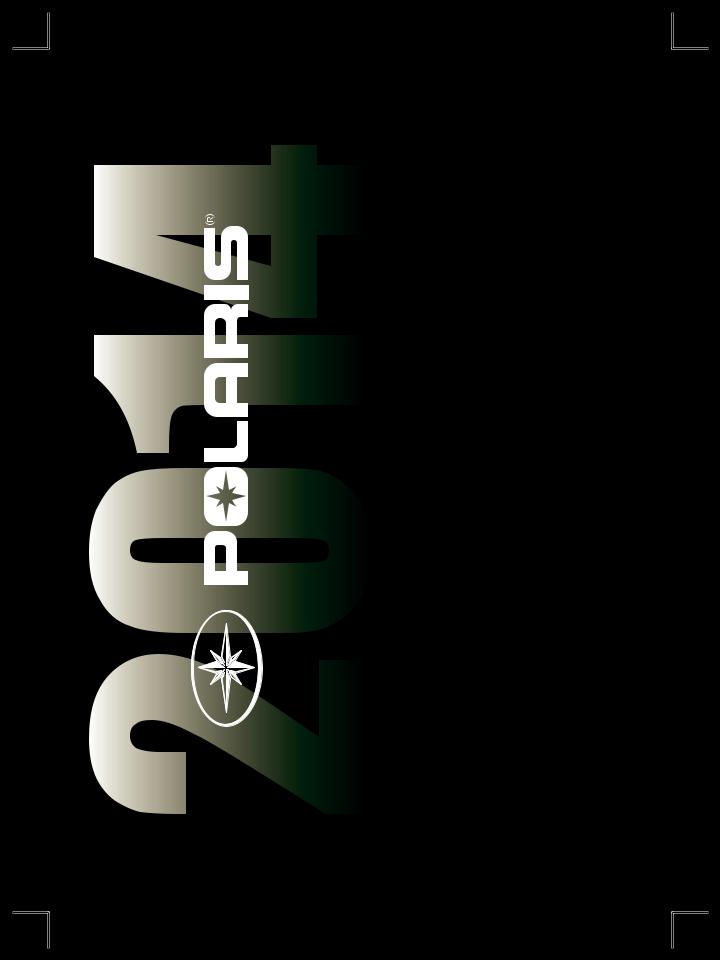
PMS 419
RANGER® 570 EFI
RANGER® 570 EPS
RANGER CREW® 570 EFI RANGER CREW® 570 EPS
Owner's Manual
for Maintenance and Safety

 WARNING
WARNING
Read, understand, and follow all of the instructions and safety precautions in this manual and on all product labels.
Failure to follow the safety precautions could result in serious injury or death.
 WARNING
WARNING
The engine exhaust from this product contains chemicals known to the State of California to cause cancer, birth defects or other reproductive harm.

WELCOME
Thank you for purchasing a POLARIS vehicle, and welcome to our world-wide family of POLARIS enthusiasts. Be sure to visit us online at www.polaris.com for the latest news, new product introductions, upcoming events, career opportunities and more.
Here at POLARIS we proudly produce an exciting line of utility and recreational products.
•Snowmobiles
•All-terrain vehicles (ATVs)
•Low emission vehicles (LEVs)
•RANGER® utility vehicles
•RZR® sport vehicles
•VICTORY® motorcycles
•GEM® electric vehicles
We believe POLARIS sets a standard of excellence for all utility and recreational vehicles manufactured in the world today. Many years of experience have gone into the engineering, design, and development of your POLARIS vehicle, making it the finest machine we’ve ever produced.
For safe and enjoyable operation of your vehicle, be sure to follow the instructions and recommendations in this owner’s manual. Your manual contains instructions for minor maintenance, but information about major repairs is outlined in the POLARIS Service Manual and should be performed only by a factory certified Master Service Dealer® (MSD) technician.
Your POLARIS dealer knows your vehicle best and is interested in your total satisfaction. Be sure to return to your dealership for all of your service needs during, and after, the warranty period.
1
POLARIS®, RANGER® and RANGER CREW® are registered trademarks of POLARIS Industries Inc.
Copyright 2013 POLARIS Sales Inc. All information contained within this publication is based on the latest product information at the time of publication. Due to constant improvements in the design and quality of production components, some minor discrepancies may result between the actual vehicle and the information presented in this publication. Depictions and/or procedures in this publication are intended for reference use only. No liability can be accepted for omissions or inaccuracies. Any reprinting or reuse of the depictions and/or procedures contained within, whether whole or in part, is expressly prohibited.
The original instructions for this vehicle are in English. Other languages are provided as translations of the original instructions.
Printed in U.S.A.
2014 RANGER 570 EFI/570 EPS and RANGER CREW 570 EFI/570 EPS Owner’s Manual P/N 9924697
2
TABLE OF CONTENTS
Introduction . . . . . . . . . . . . . . . . . . . . . . . . . . . . . . . . . . . . . . . . 4
Safety . . . . . . . . . . . . . . . . . . . . . . . . . . . . . . . . . . . . . . . . . . . . . 8
Features and Controls . . . . . . . . . . . . . . . . . . . . . . . . . . . . . . . 21
Operation . . . . . . . . . . . . . . . . . . . . . . . . . . . . . . . . . . . . . . . . . 33
Winch Guide . . . . . . . . . . . . . . . . . . . . . . . . . . . . . . . . . . . . . . . 47
Emission Control Systems . . . . . . . . . . . . . . . . . . . . . . . . . . . 56
Maintenance . . . . . . . . . . . . . . . . . . . . . . . . . . . . . . . . . . . . . . . 57
Specifications. . . . . . . . . . . . . . . . . . . . . . . . . . . . . . . . . . . . . . 88
POLARIS Products. . . . . . . . . . . . . . . . . . . . . . . . . . . . . . . . . . 90
Troubleshooting . . . . . . . . . . . . . . . . . . . . . . . . . . . . . . . . . . . . 91
Warranty . . . . . . . . . . . . . . . . . . . . . . . . . . . . . . . . . . . . . . . . . . 94
Maintenance Log . . . . . . . . . . . . . . . . . . . . . . . . . . . . . . . . . . 100
Index . . . . . . . . . . . . . . . . . . . . . . . . . . . . . . . . . . . . . . . . . . . . 102
3

INTRODUCTION
The RANGER is an off-road vehicle. Familiarize yourself with all laws and regulations concerning the operation of this vehicle in your area.
The following signal words and symbols appear throughout this manual and on your vehicle. Your safety is involved when these words and symbols are used. Become familiar with their meanings before reading the manual.
The safety alert symbol indicates a potential personal injury hazard.
DANGER
A DANGER indicates a hazardous situation that, if not avoided, will result in death or serious injury.
WARNING
A WARNING indicates a hazardous situation that, if not avoided, could result in death or serious injury.
CAUTION
A CAUTION indicates a hazardous situation that, if not avoided, could result in minor or moderate injury.
NOTICE
A NOTICE indicates a situation that could result in property damage.
The Prohibition Safety Sign indicates an action NOT to take in order to avoid a hazard.
The Mandatory Action Sign indicates an action that NEEDS to be taken to avoid a hazard.
4

INTRODUCTION
 WARNING
WARNING
Failure to follow the warnings contained in this manual can result in severe injury or death.
Your POLARIS RANGER is not a toy and can be hazardous to operate. This vehicle handles differently than other vehicles, such as cars, trucks or other off-road vehicles. A collision or rollover can occur quickly, even during routine maneuvers like turning, or driving on hills or over obstacles, if you fail to take proper precautions.
•Read this owner’s manual and review the safety DVD that came with your vehicle. A free extra copy of the DVD can be obtained by contacting your local POLARIS dealer. Understand all safety warnings, precautions and operating procedures before operating the vehicle. Keep this manual with the vehicle.
•Review the safety DVD and take the free online Recreational Off Highway Association (ROHVA) training course at www.rohva.org.
•This vehicle is an ADULT VEHICLE ONLY. You MUST be at least age 16 and have a valid driver’s license to operate this vehicle.
•No person under the age of 12 may ride as a passenger in this vehicle. All riders must be able to sit with backs against the seat, both feet flat on the floor and both hands on the steering wheel (if driving) or on a passenger hand hold.
•Never permit a guest to operate this vehicle unless the guest has read this manual and all product labels.
•Always use the cab nets (or doors) while riding in this vehicle. Always keep hands, feet and all other body parts inside the vehicle at all times.
•Always wear a helmet, eye protection, gloves, long-sleeve shirt, long pants and over-the-ankle boots.
•Never use this vehicle with drugs or alcohol, as these conditions impair judgment and reduce operator reaction time.
5
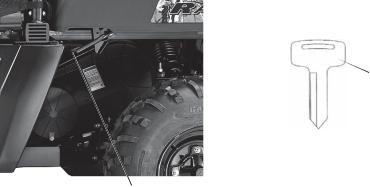
INTRODUCTION
Vehicle Identification Numbers
Record your vehicle's identification numbers and key number in the spaces provided. Remove the spare key and store it in a safe place. An ignition key can be duplicated only by ordering a POLARIS key blank (using your key number) and mating it with one of your existing keys. The ignition switch must be replaced if all keys are lost.
####
Key
Number
VIN (stamped into main frame)
Vehicle Model Number: ________________________________________________________________________
Frame VIN: _________________________________________________________________________________
Engine Serial Number: ________________________________________________________________________
Key Number: ________________________________________________________________________________
6
INTRODUCTION
European Vibration and Noise
The driver-perceived noise and hand/arm and whole body vibration levels of this machinery is measured per prEN 15997.
The operating conditions of the machinery during testing:
The vehicles were in like-new condition. The environment was controlled as indicated by the test procedure(s).
The uncertainty of vibration exposure measurement is dependent on many factors, including:
•Instrument and calibration uncertainty
•Variations in the machine such as wear of components
•Variation of machine operators such as experience or physique
•Ability of the worker to reproduce typical work during measurements
•Environmental factors such as ambient noise or temperature
7

SAFETY
Safe Riding Gear
The driver and all passengers must wear helmet, eye protection, gloves, long-sleeve shirt, long pants, over-the-ankle boots and seat belt at all times. Protective gear reduces the chance of injury.
Long |
|
Sleeves |
Eye Protection |
|
Long Pants
Gloves
Over-the-Ankle Boots |
Helmet |
Helmet
Wearing a helmet can prevent a severe head injury. Whenever riding this POLARIS vehicle, always wear a helmet that meets or exceeds established safety standards.
Approved helmets in the USA and Canada bear a U.S. Department of Transportation (DOT) label.
Approved helmets in Europe, Asia and Oceania bear the ECE 22.05 label. The ECE mark consists of a circle surrounding the letter E, followed by the distinguishing number of the country which has granted approval. The approval number and serial number will also be displayed on the label.
E4
051039
0006.31
8
SAFETY
Safe Riding Gear
Eye Protection
Do not depend on eyeglasses or sunglasses for eye protection. Whenever riding this POLARIS vehicle, always wear shatterproof goggles or use a shatterproof helmet face shield. POLARIS recommends wearing approved Personal Protective Equipment (PPE) bearing markings such as VESC 8, V-8, Z87.1, or CE. Make sure protective eye wear is kept clean.
Gloves
Wear gloves for comfort and for protection from sun, cold weather and other elements.
Boots
Wear sturdy over-the-ankle boots for support and protection. Never ride a POLARIS vehicle with bare feet or sandals.
Clothing
Wear long sleeves and long pants to protect arms and legs.
Rider Comfort
Under certain operating conditions, heat generated by the engine and exhaust system can elevate temperatures in the driver and passenger cab area. The condition occurs most frequently when a vehicle is being operated in high ambient temperatures at low speeds and/or high load conditions for an extended period of time. The use of certain windshield, roof and/or cab systems may contribute to this condition by restricting airflow. Any discomfort due to heat buildup in this area can be minimized by wearing proper riding apparel and by varying speeds to increase airflow.
9

SAFETY
Safety Labels and Locations
Warning labels have been placed on the vehicle for your protection. Read and follow the instructions of the labels on the vehicle carefully. If any of the labels depicted in this manual differ from the labels on your vehicle, always read and follow the instructions of the labels on the vehicle.
If any label becomes illegible or comes off, contact your POLARIS dealer to purchase a replacement. Replacement safety labels are provided by POLARIS at no charge. The part number is printed on the label.
Shift
Caution
Max Payload
Warning
Seat Belt/Drive
Responsibly 
Warning
Proper Use Warning
Max Payload Warning
WARNING
RANGER Mid Size |
Never Exceed |
If Total Payload Exceeds |
400 |
35 mph (56 kph) |
700 lbs. (317 kg) |
570 |
35 mph (56 kph) |
850 lbs. (385 kg) |
570 CREW |
35 mph (56 kph) |
1000 lbs. (453 kg) |
|
|
7180136 |
Proper Use Warning (570 EFI)
Require Proper Use of Your Vehicle
Do your part to prevent injuries:
•Do not allow careless or reckless driving.
•Make sure operators are 16 or older with a valid driver’s license.
•Do not let people drive or ride after using alcohol or drugs.
•Do not allow operation on public roads (unless designated for off-highway vehicle access) - collisions with cars and trucks can occur.
•Do not exceed seating capacity: 2 occupants.
7179978
10
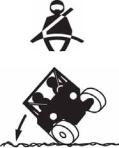
SAFETY
Safety Labels and Locations
Proper Use Warning (CREW 570)
Require Proper Use of Your Vehicle Do your part to prevent injuries:
•Do not allow careless or reckless driving.
•Make sure operators are 16 or older with a valid driver’s license.
•Do not let people drive or ride after using alcohol or drugs.
•Do not allow operation on public roads (unless designated for off-highway vehicle access) - collisions with cars and trucks can occur.
•Do not exceed seating capacity: 4 occupants.
Seat Belt/Drive Responsibly Warning
WARNING
Improper vehicle use can result in SEVERE INJURY or DEATH
Be Prepared
•Fasten seat belts.
•Wear an approved helmet and protective gear.
•ALWAYS use vehicle cab nets and/or doors.
•Each rider must be able to sit with back against seat, feet flat on the floor, and hands on steering wheel or hand holds. Stay completely inside the vehicle.
Drive Responsibly
Avoid loss of control and rollovers:
•Avoid abrupt maneuvers, sideways sliding, skidding or fishtailing, and never do donuts.
•Slow down before entering a turn.
7179980
Rollovers have caused severe injuries and death, even on flat, open areas.
•Avoid hard acceleration when turning, even from a stop.
•Plan for hills, rough terrain, ruts and other changes in traction and terrain. Avoid paved surfaces.
•Avoid sidehilling (riding across slopes).
Be Sure Riders Pay Attention and Plan Ahead
If you think or feel the vehicle may tip or roll, reduce your risk of injury:
•Keep a firm grip on the steering wheel or hand holds and brace yourself.
•Do not put any part of your body outside of the vehicle for any reason.
LOCATE AND READ OWNER’S MANUAL. FOLLOW ALL INSTRUCTIONS AND WARNINGS. ALWAYS REVIEW SAFETY VIDEO AND TAKE ROHVA TRAINING (rohva.org).
7179982
11
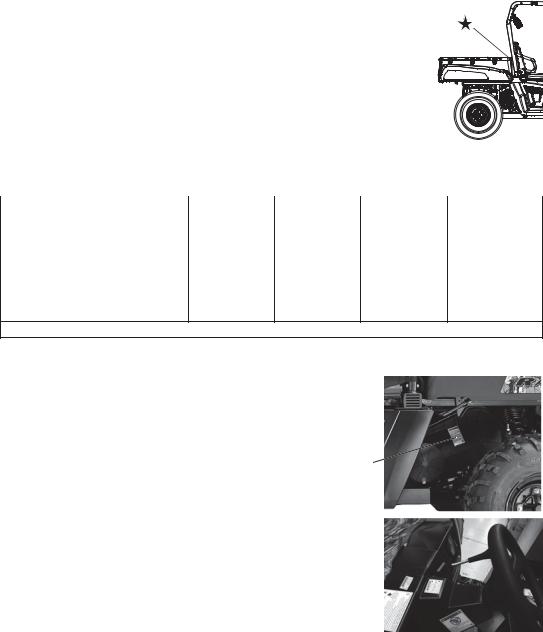
SAFETY
Safety Labels and Locations
Load/Passenger/Tire Pressure Warning
WARNING
•Passengers can be thrown off. This can cause serious injury or death.
•Never carry passengers in cargo box.
WARNING
IMPROPER TIRE PRESSURE OR OVERLOADING CAN CAUSE LOSS
OF CONTROL RESULTING IN SERIOUS INJURY OR DEATH.
•Reduce speed and allow greater distance for braking when carrying cargo.
•Overloading or carrying tall, off-center, or unsecured loads will increase your risk of losing control. Loads should be centered and carried as low as possible in box.
•For stability on rough or hilly terrain, reduce speed and cargo.
•Be careful if load extends over the side of the box.
RANGER MID-SIZE |
400/570 |
800 |
570 Crew |
LSV-EV |
MAXIMUM CARGO BOX LOAD |
500 lbs. |
500 lbs. |
500 lbs. |
500 lbs. |
|
(226 kg) |
(226 kg) |
(226 kg) |
(226 kg) |
TIRE PRESSURE IN PSI (KPa) |
FRONT 10 (69) |
FRONT 10 (69) |
FRONT 10 (69) |
FRONT 20 (138) |
|
REAR 10 (69) |
REAR 16 (110) |
REAR 14 (96) |
REAR 20 (138) |
MAXIMUM WEIGHT CAPACITY |
1000 lbs. |
1000 lbs. |
1250 lbs. |
1000 lbs. |
INCLUDES WEIGHT OF |
||||
OPERATOR, PASSENGER, |
(454 kg) |
(454 kg) |
(547 kg) |
(454 kg) |
CARGO AND ACCESSORIES |
|
|
|
|
Read Operation & Maintenance Manual for more detailed loading information.
Clutch Cover Warning
WARNING
•Moving parts hazard under belt-clutch guard. To prevent serious injury, do not operate vehicle with guard removed.
•Do not modify engine or clutch. Doing so can cause part failure, possible imbalance, and excessive engine RPM which can result in serious injury or death.
7175488
Shift Caution
CAUTION
To avoid transmission damage, shift only when vehicle is stationary and at idle.
APPLY BRAKE TO START. When this vehicle is not in operation, or unattended, place shift in the park position.
7176170
7179550
Clutch
Cover
Warning
Shift
Caution
12

SAFETY
Operator Safety
 WARNING
WARNING
Serious injury or death can result if you do not follow these instructions and procedures, which are outlined in further detail within your owner's manual.
•Read this entire manual and all labels carefully. Follow the operating procedures described.
•Never allow anyone under the age of 16 to operate this vehicle and never allow anyone without a valid driver's license to operate this vehicle.
•Do not carry a passenger until you have at least two hours of driving experience with this vehicle.
•No person under the age of 12 may ride as a passenger in this vehicle. All riders must be able to sit with backs against the seat, both feet flat on the floor and both hands on the steering wheel (if driving) or on a passenger hand hold.
•The driver and all passengers must wear helmet, eye protection, gloves, long-sleeve shirt, long pants, over-the-ankle boots and seat belt at all times.
•Always use the cab nets (or doors) while riding in this vehicle.
•Always keep hands and feet inside the vehicle at all times.
•Always keep both hands on the steering wheel and both feet on the floorboards of the vehicle during operation.
•Never permit a guest to operate this vehicle unless the guest has read this manual and all product labels.
•To reduce rollover risk, be especially careful when encountering obstacles and slopes and when braking on hills or during turns.
•This vehicle is for off road use only. Never operate on public roads (unless marked for offroad use). Always avoid paved surfaces.
•Never consume alcohol or drugs before or while operating this vehicle.
•Never operate at excessive speeds. Always travel at a speed proper for the terrain, visibility and operating conditions, and your experience.
•Never attempt jumps or other stunts.
•Always inspect the vehicle before each use to make sure it's in safe operating condition. Always follow the inspection procedures described in this manual.
13
SAFETY
Operator Safety
•Always travel slowly and use extra caution when operating on unfamiliar terrain. Be alert to changing terrain.
•Never operate on excessively rough, slippery or loose terrain.
•Always follow proper procedures for turning. Practice turning at slow speeds before attempting to turn at faster speeds. Never turn at excessive speeds.
•Always have this vehicle checked by an authorized POLARIS dealer if it has been involved in an accident.
•Never operate this vehicle on hills too steep for the vehicle or for your abilities. Practice on smaller hills before attempting larger hills.
•Always follow proper procedures for climbing hills as described in this manual. See page 38. Check the terrain carefully before attempting to climb a hill. Never climb hills with excessively slippery or loose surfaces. Never apply throttle suddenly. Never make sudden gear changes. Never go over the top of a hill at high speed.
•Always follow the proper procedures outlined in this manual for traveling downhill and for braking on hills. See page 39. Check the terrain carefully before descending a hill. Never travel downhill at high speed. Avoid going downhill at an angle, which would cause the vehicle to lean sharply to one side. Travel straight down the hill where possible.
•Always check for obstacles before operating in a new area. Never attempt to operate over large obstacles such as large rocks or fallen trees. Always follow the proper procedures outlined in this manual when operating over obstacles. See page 38.
•Always be careful of skidding or sliding. On slippery surfaces such as ice, travel slowly and exercise caution to reduce the chance of skidding or sliding out of control.
•Never operate your vehicle in fast-flowing water or in water deeper than that specified in this manual. See page 40. Wet brakes may have reduced stopping ability. Test your brakes after leaving water. If necessary, apply them lightly several times to let friction dry out the pads.
•Always be sure there are no obstacles or people behind your vehicle when operating in reverse. When it's safe to proceed in reverse, move slowly. Avoid turning at sharp angles in reverse.
14
SAFETY
Operator Safety
•Always use the proper size and type of tires specified in this manual. Always maintain proper tire pressure as specified on safety labels.
•Never modify this vehicle through improper installation or use of non-POLARIS approved accessories.
•Never exceed the stated load capacity for this vehicle. Cargo should be properly distributed and securely attached. Reduce speed and follow the instructions in this manual for hauling cargo or pulling a trailer. Allow a greater distance for braking.
•Always place the transmission in PARK before getting out of the vehicle.
•Always stop the engine before refueling. Remove flammable material containers from the box before filling them with fuel. Make sure the refueling area is well ventilated and free of any source of flame or sparks. Gasoline is extremely flammable. See page 18 for fuel safety warnings.
•Always remove the ignition key when the vehicle is not in use to prevent unauthorized use by someone under the age of 16 or without a driver’s license and proper training, or accidental starting.
FOR MORE INFORMATION ABOUT SAFETY, call POLARIS at 1-800-342-3764.
Equipment Modifications
Do not install any non-POLARIS approved accessory or modify the vehicle for the purpose of increasing speed or power. Any modifications or installation of non-POLARIS approved accessories could create a substantial safety hazard and increase the risk of bodily injury.
The warranty on your POLARIS vehicle will be terminated if any non-POLARIS approved equipment and/or modifications have been added to the vehicle that increase speed or power.
The addition of certain accessories, including (but not limited to) mowers, blades, tires, sprayers, or large racks, may change the handling characteristics of the vehicle. Use only POLARIS-approved accessories, and familiarize yourself with their function and effect on the vehicle.
15
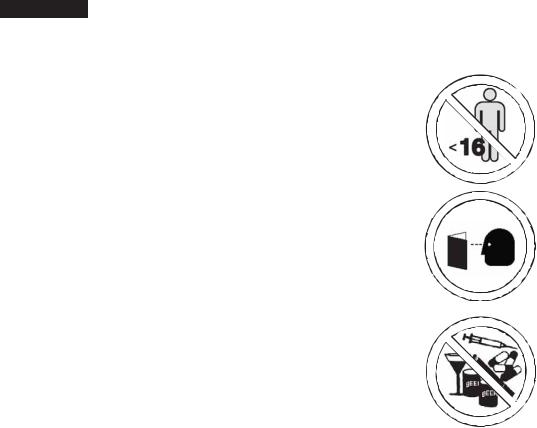
SAFETY
Operator Safety
 WARNING
WARNING
Failure to operate the RANGER properly can result in a collision, loss of control, accident or rollover, which may result in serious injury or death. Heed all safety warnings outlined in this section of the owner’s manual. See the OPERATION section of the owner’s manual for proper operating procedures.
Age Restrictions
This vehicle is an ADULT VEHICLE ONLY. NEVER operate this vehicle if you are under age 16 and NEVER operate without a valid driver’s
license.
Never operate with a passenger under the age of 12. All riders must be able to sit with backs against the seat, both feet flat on the floor and both hands on the steering wheel (if driving) or on a passenger hand hold.
Operating Without Instruction
Operating this vehicle without proper instruction increases the risk of an accident. The operator must understand how to operate the vehicle properly in different situations and on different types of terrain.
All operators must read and understand the Owner's Manual and all warning and instruction labels before operating the vehicle.
All operators should review the safety DVD provided with this vehicle and take a ROHVA training course (www.rohva.org).
Using Alcohol or Drugs
Operating the vehicle after consuming alcohol or drugs could adversely affect operator judgment, reaction time, balance and perception.
Never drink alcohol or use drugs or medications before or while operating this vehicle.
Seat Belts
Riding in this vehicle without wearing the seat belt increases the risk of serious injury in the event of rollover, loss of control, other accident or sudden stop. Seat belts may reduce the severity of injury in these circumstances.
All riders must wear seat belts at all times.
Protective Apparel
Riding in this vehicle without wearing an approved helmet and protective eyewear increases the risk of a serious injuries in the event of an accident.
Operator and all passengers must always wear an approved helmet that fits properly and eye protection (goggles or face shield).
16
SAFETY
Operator Safety
Cab Nets
Riding in this vehicle without using the cab nets (or doors, if equipped) increases the risk of serious injury or death in the event of an accident or rollover. Always use the cab nets (or doors) while riding in this vehicle.
Always keep hands and feet inside the vehicle at all times.
Failure to Inspect Before Operating
Failure to inspect and verify that the vehicle is in safe operating condition before operating increases the risk of an accident. Always perform the pre-ride inspection before each use of your RANGER to make sure it's in safe operating condition. See page 34.
Always follow all inspection and maintenance procedures and schedules described in this owner's manual. See page 57.
Operating With a Load on the Vehicle
The weight of both cargo and passengers impacts vehicle operation. For your safety and the safety of others, carefully consider how your vehicle is loaded and how to safely operate the vehicle. Follow the instructions in this manual for loading, tire pressure, gear selection and speed.
•Do not exceed vehicle weight capacities. The vehicle’s maximum weight capacity is listed in the specifications section of this manual and on a label on the vehicle. When more passenger weight is added, cargo weight may need to be reduced accordingly.
•The recommended tire pressures are listed in the specifications section of this manual and on a label on the vehicle.
Always follow these guidelines:
Under ANY of these conditions: |
Do ALL of these steps: |
||
Passenger and/or cargo exceeds half the maximum weight capacity |
1. Slow down. |
||
|
2. |
Verify tire pressure. |
|
Operating in rough terrain |
|||
3. |
Use extra caution when |
||
|
|||
Operating over obstacles |
|||
|
operating. |
||
|
|
||
Climbing an incline |
|
|
|
|
|
|
|
Towing |
|
|
|
|
|
|
|
17
SAFETY
Operator Safety
Handling Gasoline
Gasoline is highly flammable and explosive under certain conditions.
•Always exercise extreme caution whenever handling gasoline.
•Always turn off the engine when refueling.
•Always refuel outdoors or in a well ventilated area free of any source of flame or sparks.
•Always use an approved gasoline container to store fuel and remove the container from the vehicle before filling to avoid fuel ignition due to electrical static discharge.
•Do not smoke or allow open flames or sparks in or near the area where refueling is performed or where gasoline is stored.
•Do not overfill the tank. Do not fill the tank neck.
•If gasoline spills on your skin or clothing, immediately wash it off with soap and water and change clothing.
Exposure to Exhaust
Engine exhaust fumes are poisonous and can cause loss of consciousness or death in a short time. Never start the engine or let it run in an enclosed area.
The engine exhaust from this product contains chemicals known to cause cancer, birth defects or other reproductive harm. Operate this vehicle only outdoors or in well-ventilated areas.
Operating a Damaged Vehicle
Operating a damaged vehicle can result in an accident. After any rollover or other accident, have a qualified service dealer inspect the entire machine for possible damage, including (but not limited to) seat belts, rollover protection devices, brakes, throttle and steering systems.
Operating at Excessive Speeds
Operating this vehicle at excessive speeds increases the operator's risk of losing control. Always operate at a speed that's appropriate for the terrain, the visibility and operating conditions, your skills and experience and your passengers’ skills and experience.
Operating on Pavement
This vehicle's tires are designed for off-road use only, not for use on pavement. Operating this vehicle on paved surfaces (including sidewalks, paths, parking lots and driveways) may adversely affect the handling of the vehicle and may increase the risk of loss of control and accident or rollover. Avoid operating the vehicle on pavement. If it's unavoidable, travel slowly, travel short distances and avoid sudden turns or stops.
18
SAFETY
Operator Safety
Operating on Public Roads
Operating this vehicle on public streets, roads or highways could result in a collision with another vehicle. Never operate this vehicle on any public street, road or highway, including dirt and gravel roads (unless designated for off-highway use). In some areas it's unlawful to operate this vehicle on public streets, roads and highways.
Turning Improperly
Turning improperly could cause loss of traction, loss of control, accident or rollover. Always follow proper procedures for turning as described in this owner's manual. Never turn abruptly or at sharp angles. Never turn at high speeds. Practice turning at slow speeds before attempting to turn at faster speeds.
Jumps and Stunts
Attempting wheelies, jumps and other stunts increases the risk of an accident or rollover. Never attempt wheelies, jumps, or other stunts. Avoid exhibition driving.
Operating in Unfamiliar Terrain
Failure to use extra caution when operating on unfamiliar terrain could result in an accident or rollover. Unfamiliar terrain may contain hidden rocks, bumps, or holes that could cause loss of control or rollover. Travel slowly and use extra caution when operating on unfamiliar terrain. Always be alert to changing terrain conditions.
Improper Hill Climbing
Climbing hills improperly can cause loss of control or vehicle rollover. Always follow proper procedures for climbing hills as described in this owner's manual. See page 38.
Descending Hills Improperly
Improperly descending a hill could cause loss of control or rollover. Always follow proper procedures for traveling down hills as described in this owner's manual. See page 39.
Stalling While Climbing a Hill
Stalling or rolling backwards while climbing a hill could cause a rollover. Always maintain a steady speed when climbing a hill.
If all forward speed is lost:
•Apply the brakes.
•Place the transmission in reverse and slowly allow the vehicle to roll straight downhill while applying light brake pressure to control speed.
If you begin rolling downhill:
•Never apply engine power.
•Apply the brakes gradually until the vehicle is fully stopped.
•Place the transmission in reverse and slowly allow the vehicle to roll straight downhill while applying light brake pressure to control speed.
19
SAFETY
Operator Safety
Improper Tire Maintenance
Operating this vehicle with improper tires or with improper or uneven tire pressure could cause loss of control or accident. Always use the size and type of tires specified for your vehicle. Always maintain proper tire pressure as described in the owner's manual and on safety labels.
Operating on Slippery Terrain
Failure to use extra caution when operating on excessively rough, slippery or loose terrain could cause loss of traction, loss of control, accident or rollover. Do not operate on excessively slippery surfaces. Always slow down and use additional caution when operating on slippery surfaces.
Skidding or sliding due to loss of traction can cause loss of control or rollover (if tires regain traction unexpectedly). Always follow proper procedures for operating on slippery surfaces as described in this owner's manual. See page 37.
Operating on Frozen Bodies of Water
Severe injury or death can result if the vehicle and/or the operator fall through the ice. Never operate the vehicle on a frozen body of water unless you have first verified that the ice is sufficiently thick to support the weight and moving force of the vehicle, you and your passengers, and your cargo, together with any other vehicles in your party.
Always check with local authorities and residents to confirm ice conditions and thickness over your entire route. Vehicle operators assume all risk associated with ice conditions on frozen bodies of water.
Unauthorized Use of the Vehicle
Leaving the keys in the ignition can lead to unauthorized use of the vehicle by someone under the age of 16, without a drivers license, or without proper training. This could result in an accident or rollover. Always remove the ignition key when the vehicle is not in use.
Hot Exhaust Systems
Exhaust system components are very hot during and after use of the vehicle. Hot components can cause burns and fire. Do not touch hot exhaust system components. Always keep combustible materials away from the exhaust system. Use caution when traveling through tall grass, especially dry grass, to avoid debris build-up around the exhaust system.
20
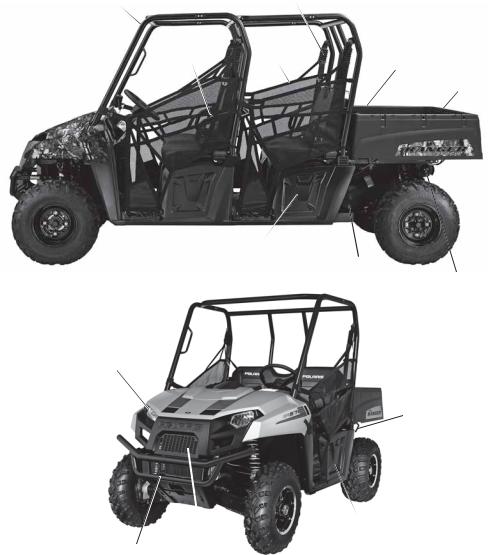
FEATURES AND CONTROLS
Vehicle Components
Not all models come with all features. Refer to the specifications section beginning on page 88.
ROPS Cab |
Seat Belts |
|
Frame |
|
|
|
|
|
Hip Bar |
Cab |
|
Net |
Cargo Box |
|
|
|
Tailgate
CREW 570
570
Electrical Clutch Box
Compartment Muffler
(Spark Arrester)
Headlights
Cargo Box
 Release
Release
Lever
Radiator |
570 EFI |
Electrical |
|
Front Bumper/Brush Guard |
Compartment |
21
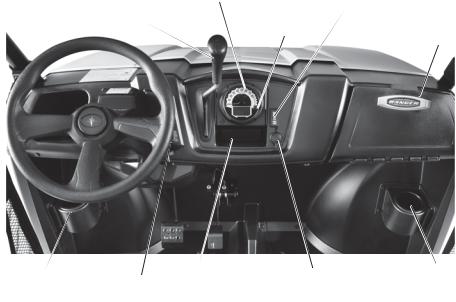
FEATURES AND CONTROLS
Console
|
Instrument |
|
AWD/Differential Switch |
Gear Selector |
Cluster |
|
|
|
Mode |
|
|
(Shifter) |
|
Storage |
|
|
|
Button |
|
|
|
|
Compartment |
Cup Holder Ignition Switch |
Storage |
12V Auxiliary |
Cup Holder |
Tray |
Outlet |
|
|
Light Switch |
|
|
|
Auxiliary Outlet
The 12-volt receptacle has spade connections on the back that may be used to power an auxiliary light or other optional accessories or lights. The connections are behind the console, under the hood.
Mode Button
The yellow button located near the instrument cluster is used to toggle through mode options available. See pages 28-32.
Ignition Switch/Light Switch
The ignition switch is a four-position, key-operated switch. The key can be removed from the switch when it is in the OFF position.
OFF |
The engine is off. Electrical circuits are off, except Acc, 12V. |
LIGHTS ON |
Lights are on. Electrical circuits are on. Electrical equipment can be used. |
LIGHTS OFF |
Lights are off. Electrical circuits are on. Electrical equipment can be used. |
|
|
START |
Turn the key to the START position to engage the electric starter. Turn the key |
|
to the LIGHTS ON position after starting the engine. |
22
FEATURES AND CONTROLS
Console
Gear Selector
H: High Gear
L: Low Gear
N: Neutral
R: Reverse P: Park
Low gear is the primary driving range for the RANGER. High gear is intended for use on hard-packed surfaces with light loads. Whenever the vehicle is left unattended, always place the transmission in PARK.
To change gears, stop the vehicle, and with the engine idling, move the lever to the desired gear. Do not attempt to shift gears with engine speed above idle or while the vehicle is moving.
Tip: Maintaining shift linkage adjustment is important to assure proper transmission function. See your dealer if you experience any shifting problems.
NOTICE: Shifting gears with the engine speed above idle or while the vehicle is moving could cause transmission damage. Always shift when the vehicle is stationary and the engine is at idle.
Using Low Range
Always shift into low gear for any of the following conditions.
•Operating in rough terrain or over obstacles
•Loading the vehicle onto a trailer
•Towing heavy loads
AWD/Differential Lock Switch
The AWD/Differential Switch has three positions: All Wheel Drive (AWD), Differential Lock/Two Wheel Drive (2WD) and Off (1WD/Turf Mode).
Press the top of the rocker switch to engage All Wheel Drive (AWD). See page 46 for AWD operating instructions.
Move the rocker switch to the center position to lock the differential and operate in two wheel drive (2WD). See page 45 for Differential Lock operating instructions.
Press the bottom of the switch to unlock the differential and allow the rear drive wheels to operate independently (1WD). This mode of operation is well suited to turf driving or when active traction is not needed.
23
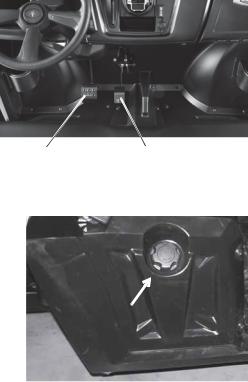
FEATURES AND CONTROLS
Brake Pedal
Depress the brake pedal to slow or stop the vehicle. Apply the brakes while starting the engine.
Throttle Pedal
Push the pedal down to increase engine speed. Spring pressure returns the pedal to the rest position when released. Always check that the throttle pedal returns normally before starting the engine.
This vehicle is equipped with a throttle release switch, which is designed to reduce the risk of a frozen or stuck throttle. If the throttle cable should stick in an open position when the operator releases the throttle pedal, engine speed will be limited, and power to the rear wheels will be reduced.
Brake |
Throttle |
Pedal |
Pedal |
Fuel Cap
The fuel tank filler cap is located on the righthand side of the vehicle near the passenger seat. When refueling, always use either leaded or unleaded gasoline with a minimum pump octane
number of 87 R+M/2 octane. Do not use fuel with ethanol content greater than 10 percent, such as
E-85 fuel.
Seat Removal
Pull up on the front of the seat and slide it toward the front of the vehicle. Install the seat by sliding the tabs into the rear of the seat base. Push down firmly on the front of the seat until the pins are fully seated into the grommets.
Electronic Power Steering (EPS)
Electronic power steering (if equipped) engages when the ignition key is turned to the ON position. EPS remains engaged whether the vehicle is moving or idle.
To conserve battery power, the EPS will shut down 5 minutes after the engine is stopped if the key remains in the ON position. The EPS warning indicator will illuminate to indicate the EPS has shut down. Turn the key off and on to reset the unit.
See page 28 for EPS warning indicator information.
24
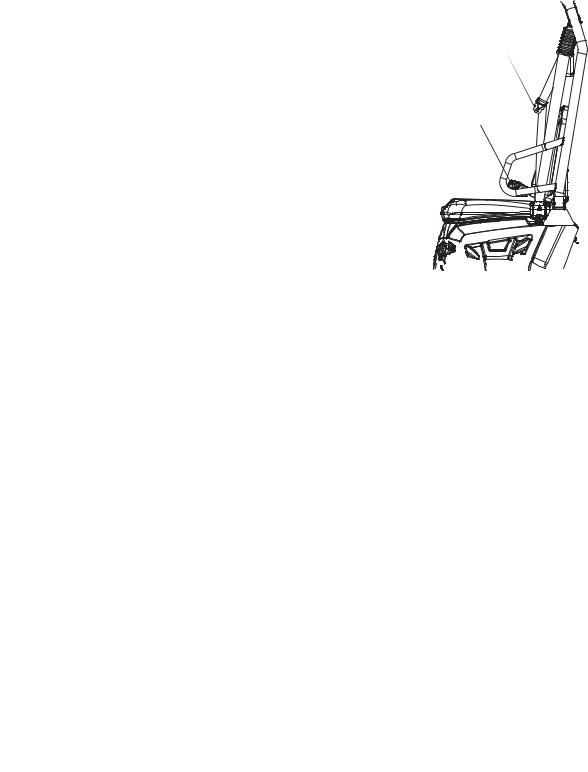
FEATURES AND CONTROLS
Seat Belts
This POLARIS vehicle is equipped with three-point lap and diagonal seat belts on all external seats. Always make sure the seat belts are secured for all riders before operating.
WARNING! Falling from a moving vehicle could result in serious injury or death. Always fasten your seat belt securely before operating or riding in the RANGER.
To wear the seat belt properly, follow this procedure:
1.For 3-point belts, pull the seat belt latch downward and across your chest toward the buckle at the inner edge of the seat. The belt should fit snugly across your hips and diagonally across your chest. Make sure the belt is not twisted.
2.Push the latch plate into the buckle until it clicks.
3.Release the strap, it will self tighten.
Tip: The center belt must be tightened manually by pulling on the strap.
4.To release the seat belt, press the square red button in the buckle's center.
Seat Belt Inspection
Latch Plate
Buckle
Inspect all seat belts for proper operation before each use of the vehicle.
1.Push the latch plate into the buckle until it clicks. The latch plate must slide smoothly into the buckle. A click indicates that it's securely latched.
2.Push the red release latch in the middle of the buckle to make sure it releases freely.
3.Pull each seat belt completely out and inspect the full length for any damage, including cuts, wear, fraying or stiffness. If any damage is found, or if the seat belt does not operate properly, have the seat belt system checked and/or replaced by an authorized POLARIS dealer.
4.To clean dirt or debris from the seat belts, sponge the straps with mild soap and water. Do not use bleach, dye or household detergents. Rinse the entire length of the belt webbing. Use a garden hose to flush out the retractor and latch housings regularly.
25
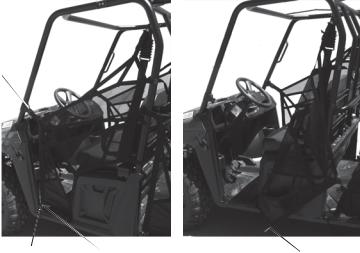
FEATURES AND CONTROLS
Cab Nets
Riding in this vehicle without using the cab nets (or doors, if equipped) increases the risk of serious injury or death in the event of an accident or rollover. Cab nets (or doors) must be used by both operator and passengers at all times. Make sure all latches are secure before operating the vehicle.
Always inspect cab nets and latches for tightness, wear and damage before each use of the vehicle. Use the strap adjusters to tighten any loose straps. Promptly replace worn or damaged cab nets and latches with new cab nets and latches. Please see your authorized POLARIS dealer.
Securing a Net
1.After entering the vehicle, insert the lower net rod into the net mount on the floor. Make sure the ball at the end of the rod is properly secured in the slot at the base of the mount.
2.Connect the latch at the top edge of the net to the receiver latch mounted on the front frame.
Opening a Net
1.To exit the vehicle, release the top front latch.
2.Rotate the net rearward and slide the lower net rod out of the mount to remove it.
3.Allow the net to hang freely outside the vehicle while dismounting.
Top
Latch
Rod Mount |
Net Rod |
Net Rod |
26
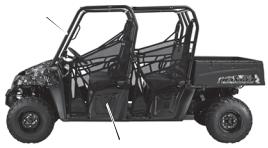
FEATURES AND CONTROLS
Rollover Protective Structure (ROPS)
The Rollover Protective Structure (ROPS) on this vehicle meets OSHA 1928.53 rollover performance requirements. Always have your authorized POLARIS dealer thoroughly inspect the ROPS if it ever becomes damaged in any way.
No device can assure occupant protection in the event of a rollover. Always follow all safe operating practices outlined in this manual to avoid vehicle rollover.
WARNING! Vehicle rollover could cause severe injury or death. Always avoid operating in a manner that could result in vehicle rollover.
ROPS (all models)
Storage Compartment
(CREW only)
Storage Compartments
A storage compartment is located under the driver’s seat on CREW models.
Trailer Hitch Bracket
This vehicle is equipped with a receiver hitch bracket for a trailer hitch. Trailer towing equipment is not supplied with this vehicle.
To avoid injury and property damage, always heed the warnings and towing capacities outlined on pages 42-43.
Extreme Use 30 AH Battery (Non-EPS Models Only)
If your factory-installed battery cannot maintain a charge because of operation in extreme cold or with multiple electrical accessories, please see your POLARIS dealer to purchase a 30 AH battery. To install this battery to your vehicle, you will also need to purchase the 30 AH battery strap bracket. See page 90 for the part numbers of POLARIS products.
1.Fully charge the new battery before installing it. See page 83.
2.To install the 30 AH battery, remove the existing battery. See page 81.
3.Remove the plastic spacer at the bottom of the battery compartment. Save the spacer for future use.
4.Install the new battery. See page 82.
27
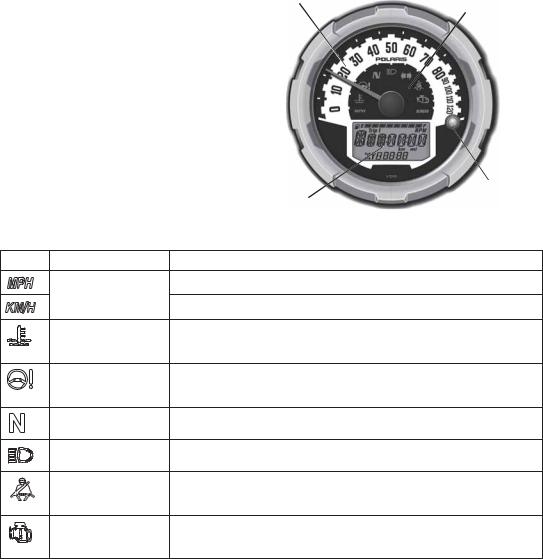
FEATURES AND CONTROLS
Instrument Cluster
High water pressure may damage components. Wash the vehicle by hand or with a garden hose using mild soap. Do not use alcohol to clean the instrument cluster. Do not allow insect sprays to contact the lens.
Speedometer
The speedometer displays vehicle speed in either miles per hour (MPH) or kilometers per hour (km/h). See page 30.
Speedometer |
Indicator |
|
Lamps |
Rider |
MODE |
Information |
Button |
Center |
|
Indicator Lamps |
|
|
Lamp |
Indicates |
Condition |
|
Vehicle Speed |
When standard mode is selected, speed displays in miles per hour. |
|
When metric mode is selected, speed displays in kilometers per hour. |
|
|
|
|
|
Over Temperature |
This lamp illuminates to indicate an overheated engine. If the |
|
|
indicator flashes, the overheating condition remains, and the system |
|
|
will automatically reduce engine power. |
|
EPS Warning |
This indicator illuminates briefly when the key is turned to the ON |
|
|
position. If the light remains on, the EPS system is inoperative. See |
|
|
your authorized POLARIS dealer for service. |
|
Neutral |
This lamp illuminates when the transmission is in neutral and the |
|
|
ignition key is in the ON position. |
|
High Beam |
This lamp illuminates when the headlamp switch is set to high beam. |
|
Helmet/Seat Belt |
This lamp flashes for several seconds when the key is turned to the |
|
|
ON position. The lamp is a reminder to the operator to ensure all |
|
|
riders are wearing helmets and seat belts before operating. |
|
Check Engine |
This indicator appears if an EFI-related fault occurs. Do not operate |
|
|
the vehicle if this warning appears. Serious engine damage could |
|
|
result. See your dealer. |
28
